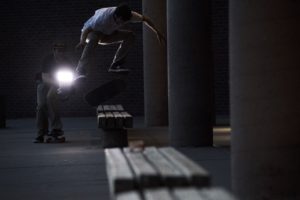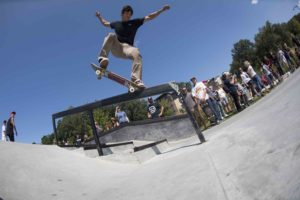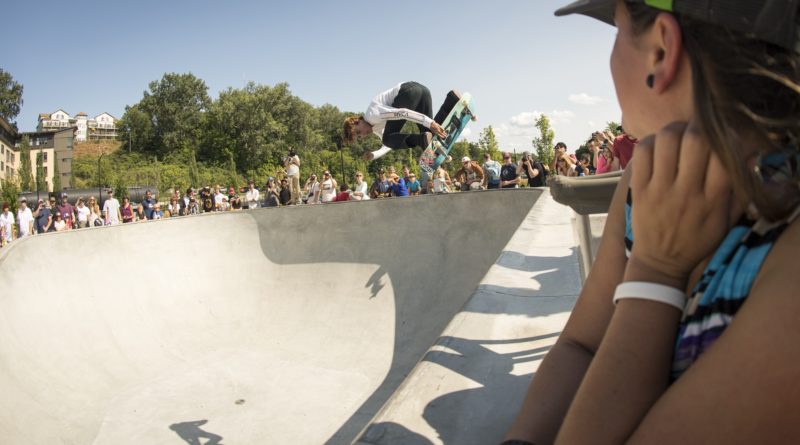Vermont Skateboarders Ramp It Up
Vermont skateboarders come home and show why they’re now some of the best in the world.
On August 26, 2017, Sean Malto, Curran Caples, Chris Colbourn, Jordan Maxham, and ex-pro brothers Marc and Andre Razo bombed down Burlington’s Battery Street, hugged the corner onto College Street and ripped right past the Skinny Pancake. Hanging a right, they rolled through the waterfront park until they reached Burlington’s year-and-a-half-old A-Dog Williams Skatepark, which sits overlooking Lake Champlain and the Adirondacks.
For four of the world-class skaters, the day marked a homecoming. Colbourn originally hails from Williston; Maxham is from Barre. The Razo brothers, now legends in skate culture, grew up in Bennington and went to University of Vermont.
The occasion? Burlington’s fourth annual A-Dog Day. DJ and artist, Andy “A-Dog” Williams was a core member of the Burlington skate scene up until December 26, 2013, when he died after a long battle with acute myeloid leukemia. The skatepark, which opened in November 2015, was named after A-Dog. August 26 now marks A-Dog day in Burlington—a day of skating, music and art is held in his honor.

Soon enough, the park was packed. A swarm of skaters, locals, curious tourists, runners and cyclists surrounded the park’s centerpiece: a 150-square-foot, 10-foot-deep bowl. Bass beats pounded from a nearby DJ as, one by one, skater after skater dropped into the bowl, flying up its walls and ollieing (skater word for “jump”) from one feature to the next until they either hopped neatly back onto the bowl’s lip or lost control of the board. The latter resulted in a less-than-graceful scurry up the giant drop, at which point the next skater would dip in to take their turn.
Curran Caples, son of pro surfer Evan Caples and hailed as one of the country’s best bowl skaters, garnered “ooh’s and ah’s” as he fluidly transitioned from wall to wall. “He’s gotta be pro,” one cyclist said as Caples flew by. “You can really tell the difference.”
The Mountain Dew team, hailing almost entirely from California, had come to see Burlington’s new park for themselves. “This skate park has gotten really widely known throughout the skate community,” said Sean Malto, who has medaled in the X-Games. “I just wanted to check it out.”
And they aren’t the first pros to make an appearance in Burlington. Though it officially opened to the public almost two years ago, the park celebrated its grand opening in June of 2016. The Tony Hawk Foundation put $10,000 towards the $1.4 million park, and the skating legend himself made an appearance, christening the bowl with his signature “McTwists.”
The skatepark is, in part, the brainchild of Brendan Foster, who co-owns Maven Skate Shop on Church Street; he helped lead the 8-year-long effort to build a park that would last. “It’s not just Burlington,” he said. “This park means a lot for New England.”
Now, a year and a half later, the park is responsible for big changes in Burlington’s skate scene.
 The Demand
The Demand
Burlington has always had a skate scene. Before the A-Dog Skatepark was created, skaters grinded stair rails at UVM and bombed down the hilly streets.
Some skaters used the city’s old wooden skate park, located near the waterfront, but it wasn’t anything to write home about. “The big issue with wooden parks is that they don’t last long,” Foster said. “We have severe weather up here; we have long winters. We were huge advocates for building a concrete skate park that could last a long time and be here for 30 to 40 years. With wooden parks, you’re really getting a shelf life of like 5 years out of them.”
That park, with its gates and fences, was hidden from the public eye, and produced some angst from locals who were wary of the skate culture.
So when Maven Skate Shop opened in 2008 and immediately pulled for a permanent, state-of-the
-art park, some locals were worried. Kirsten Merriman-Shapiro, with Burlington’s Community and Economic Development Office, was the project manager for the park, and encouraged the community to push forward.
“Some of the neighbors didn’t want a bigger, better skate park,” she said. “And that’s where the community came together. People who skated at the park when they were 15-years-old were like, ‘I’m 25, I have a good job, I still like to skate—I’m a valid, valuable member of the community.’ And I think that really changed the perception. Some of the counselors began to realize that this is a larger segment of the population than they thought. It’s multi-generational, because skateboarding’s been around for a while, and people wanted to have a place where they could skate with their kids.”
The Outcome
After eight years of fundraising, deliberation and pushing forward, the waterfront park was completed. Designed by Seattle-based Grindline, its 21,250 square feet look out on the waterfront and sit directly next to the brand-new, $6 million Community Sailing Center and the Moran Plant. Park features include large and miniature bowls, three rails, several sets of stairs, mani pads (including one in the shape of Vermont), and perhaps its signature feature: a steep triangular quarter-pipe called the “sail.”
Chris “Cookie” Colbourn, on Mountain Dew’s team, grew up skating at Talent Skatepark in South Burlington. He paid for the $500 yearly membership by teaching skating lessons, working the snack counter and picking up recycled bottles from the park’s indoor arena. The 26-year-old says the waterfront park has changed the city’s skating game.
“I was one of maybe 10 skateboarders at my high school, and from what I can see from this waterfront park, its bringing more people out than ever,” Colbourn said. “I have a lot of friends from high school who tell me they haven’t stepped on a board in years, but they decided to come down since this is here. This park is doing a great job by bringing out people who may not go pay for a session indoors.”
And Foster thinks the new park, now recognized as one of the best in the Northeast, has put Burlington on the map.
“People credit Burlington with being on the forefront of this,” he said. “Maybe the new park in Nashua wouldn’t have happened if we didn’t do it first. I’m hearing it from a lot of skaters that we’re making an impact.”
Though the park is smaller physically and budget-wise than other skate Meccas around the country, he considers it one of the nation’s best parks with regard to quality and terrain. “It’s big enough for someone like Tony Hawk to come here and have fun skating it, but it has a large enough variety where young kids can skate it, little kids can skate it,” he said, adding that it’s attracted skaters from around the Northeast.
“We’ve had a lot more traffic in the shop. We have a lot of people coming down from Canada, from Montreal, and we have people from all over New England. They put it on their skate trip road map—they’ll hit the Boston park, and then they’ll come here. That’s just part of the culture, that’s what skaters do.”
Flanked by the waterfront park and Burlington Bike Path, the park is directly in the public eye, which adds a safety component and allows skaters to mingle with non-skaters. It also puts the idea of skating into the minds of those who may not have given the sport much thought.
“I look at the community that comes down for A-Dog Day,” Merriman-Shapiro said, “It’s diverse socioeconomically, racially it’s more diverse than some activities that I see, and gender diverse—I see more and more girls and women using the facilities. Skating’s so fun to watch. Maybe you’re not a skateboarder, but you’re on the amazing rec path that goes right by the park. You can stop and watch people do tricks, and you’re like, ‘that was awesome,’ and then you begin these conversations with other people who are watching, so it’s that kind of community, too—on the fly, in that moment. Just making those human-to-human connections is fantastic.”
The Tribute
Talk to any member of Burlington’s skating community, and you won’t get far into the conversation before they bring up the park’s namesake. From the park’s dedicated name to the A-Dog-inspired mural, painted by his longtime girlfriend, Jozie Furchgott Sourdiffe, that decorates a park wall, Andy Williams’ presence is very much alive among those who knew him well, and those who never knew him at all.
“He had this aura around him,” says Hannah Deene, owner of Talent Skatepark. Deene worked with Andy for years at Talent, and before that at the B-Side, another shop in town. “You just wanted to be with him. He was like this Burlington drug that everybody craved more of, and when he passed, you could see it. The streets were filled. Everyone was crying. No one knew what to do with themselves, because whether you were into music, whether you were into skateboarding, whether you called Church Street your hangout spot, whatever nightclub you went to, everyone knew Andy. So it was completely devastating, and everyone thought that he was their best friend, because that’s what he wanted. That was real. You have never met a more real person.”
For Sean Malto and Curran Caples, A-Dog is a force to be honored, and an inspiration to the skate scene. “I know his story, and my friends here have been telling me how special he was,” Malto said. “It’s easy to tell. The guy has a skatepark named after him, and the whole community comes together. I’m bummed I didn’t get to meet him, but I’m psyched to be able to support the cause.”
For Deene and others who were close to Williams, A-Dog Day, and the park as a whole, is a tribute.
“This A-Dog reunion is when the skaters come back,” Deene said. “You’ll see them bomb the hill right down to the skate park in a posse that makes my eyes ‘wow,’ because it’s the full crew. They all come back to town, all in the name of Andy, and it’s just this massive, incredible, magical, fierce reunion with so much love. So much love. I know he’s here for that. And I know he would be beside himself with joy.”

